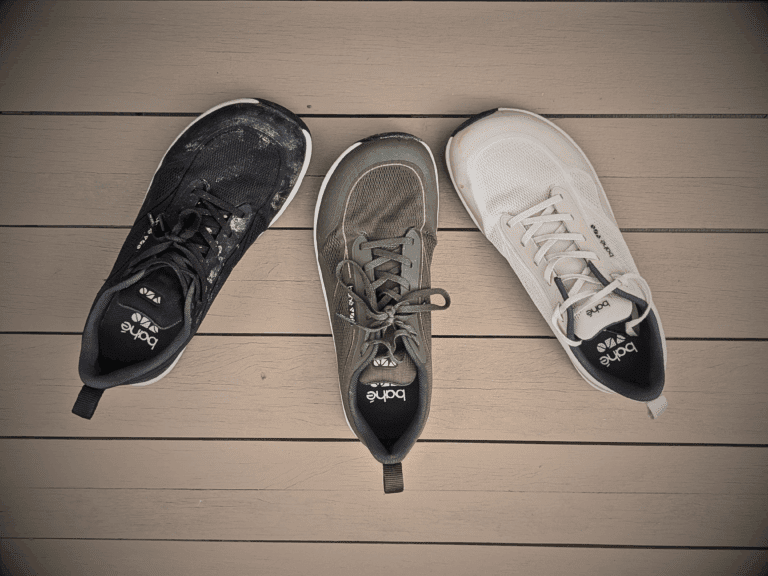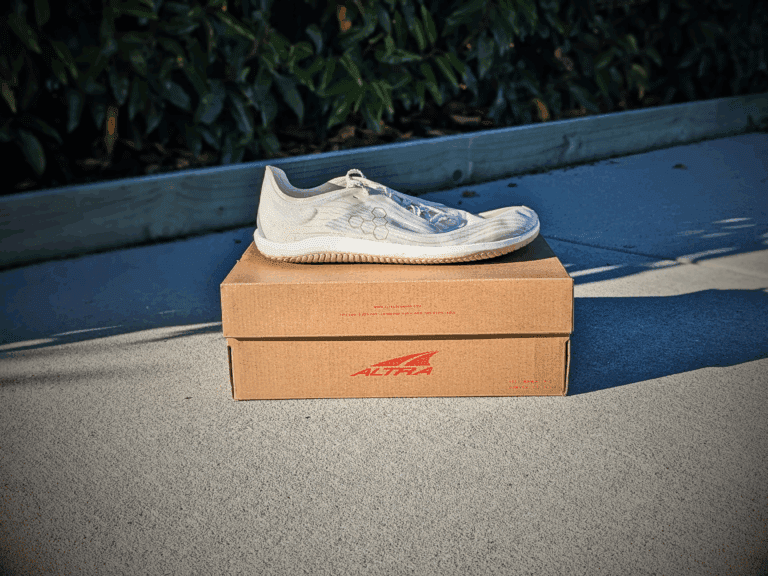The Mesa Trail II is now available!
If you want the latest and greatest, go and check out our review on the Mesa Trail. The upgrade is well worth the money. It’s quickly become my daily trainer!
I’m a minimalist shoe fan, and if you’re looking at a Xero Shoes Mesa Trail shoe review, then I’m guessing you are too. Or at least you’re curious.
This wide-toe box, minimalist trail runner is one of only a few barefoot and true trail running shoes out there.
And with Xero Shoes offering an awesome 5000-mile sole warranty, you should get your money’s worth, right? You’ll have to keep on reading to find that one out.
I’ve been rocking the Mesa Trails for 600km now, and I’m really happy to say they are just what I was looking for. But the all-important fit was a little tricky at first, you’ll almost certainly need a different size from your standard shoe. The Mesa Trail II fits true to size.
Wanna see some well-worn Mesa Trails? Watch the video below. (Maybe I should have given them a good wash first?)
Wanna know the details, skip down and keep on reading.
Affiliate Disclosure: By clicking through the links on this page and purchasing the products, you’ll be helping me out. This is done because I receive a kickback from the sellers at no extra cost to you! Thank you so much for supporting us!

Xero Shoes Mesa Trail
The closest to barefoot you’re going to get.
Here’s the important one. How do they fit? And what’s my size recommendation?
To ensure a proper fit, go ½ a size larger! Even Xero Shoes suggests you buy ½ a size larger than your normal shoe size. Sometimes Xero Shoes have these inconstancies, but don’t fret too much with the sizing. When you buy direct from Xero Shoes, they offer free exchanges, to make sure you’re 100% happy.
The all new Mesa Trail II is said to fit true to size. Keep an eye out for the review coming soon!
The standout feature of the shoe is deep airy toe box. Yes, the toe box is moderately wide, but having that depth to the shoe is refreshing, allow for the toes to wiggle in every direction.
Moving up the shoe, the lacing system is based loosely on a traditional Huarache sandal. If you’ve ever worn any Xero sandals, you’ll be familiar with the strap system, except this time, they’re hidden behind an outer layer to protect from any abrasion or wear.
Two midfoot straps run from the soles and loop into the lacing system, and two instep straps mirror the outer straps to create a comfortable fit but still allow natural movement.
Which minimal running shoe is for you?
Take a quick 5-question quiz to identify the perfect minimal running shoe for your feet! You'll get both road and trail options based on your answers!
There is a good depth throughout the whole shoe, which could be a positive or negative depending on your feet. If you happen to have shallow, less voluminous feet, there could be a little bunching in the lacing area, in that case. Personally, I’ve found the lacing lockdown to be okay, and I would say I have a fairly average foot depth.
The ankle opening is relatively large, and I had to utilize a lace lock to get a good ankle hold. But once I found the proper fit, I was more than comfortable on longer runs and had no rubbing or sore spots from the get-go.
These shoes are super lightweight at only 8.5oz (240g) in a Mens 9.5 US. Less weight on the feet means a smoother airy running feeling, helping add to the true barefoot style.
The thin and super breathable mesh upper ensures your feet don’t overheat on those hot days. And because the mesh is so minimal, it means that water drains away very fast. Conversely if you run in wet cold or freezing temperatures, it’s a good idea to wear some nice thick socks, because your feet will get cold!
The lightweight mesh is paired with an old-school reinforced toe box for extra protection. That old-school look and material choice means I’m 100% confident that I’m never going to tear or break through, and if I ever kick a rock, at least I won’t break a toe! Some times old-school is the best way to go.
Underfoot, the super flexible sole offers a balance of ground feel and protection. The 3.5mm insole is removable, which is great for those who love to be closer to the ground. If you are running on well-maintained muddy tracks, removing the insole could be ideal, but I’d suggest keeping it in for those rocky mountain trails.
I’ve even taken it a step further and used the Altra Superior rock guard in my Mesa Trails. I was amazed at what a difference a thin piece of plastic can make, especially over sharp rocks. Just to note, if you want to do this, the Altra Superiors have to be 1 full size small than the Xero Shoes Mesa Trails.
The dual-chevron tread outsole pattern works wonders on dry rocks. The arrow lug design allows for perfect grip over many different conditions, whether you’re running in wet, muddy, or dry conditions, but they do wear fair quick when used on hard surfaces, or tarmac. So keep these shoe strictly trail bound.
Gait Analysis
Something I like to look at is how the shoes affect my gait.
I do this with RunScribe foot pods, which offer up interesting force and foot swing data, showing if I land harder, softer, extend or shorten my stride, and more.

From the image, you can see the average of my foot strikes during a 1.3-mile shoe study performed on a fairly flat soft trail.
You can see that I’m obviously a forefoot runner, but that’s just natural when you move to barefoot shoes. And then rolling to the outside of the foot to provide cushioning from the impact.
The reduction in impact can be backed up by comparing the force I hit the ground in the Mesa Trail’s vs. the Altra Superior, a more cushioned shoe.
On the same 1.3-mile loop the impact forces were 5.4G in the Mesa’s and 6.5G in the Altra Superiors.
Although that was countered by higher braking forces (reduction in forward motion). This time we had 12.5G for the Mesa’s and 12.1G in the Superior.
The simple way to interpret this is, if you have pain in your knees and hips, you could be a great shoe to try and incorporate Xero Shoes Mesa Trails to reduce the impact forces in your legs and enable proper posture.
But if you struggle with shin splints, calf/achiles pain, you could be better off trying a more cushioned shoe.
Coming in at $119.99 RRP, the Xero Shoes Mesa Trail shoes are on the cheaper end of the trail shoe market price. A trend that tends to be true across much of the Xero Shoes shoe range.
Every now and then, you’ll find that Xero Shoes are having a sale, and you can find odd sizes and colors being sold at 30% of the price. Now that’s a great deal!
To make the price even sweeter, the 5000-mile sole guarantee means that you can be confident that the shoe should last. I’ll keep you posted.
I also find that the lack of cushioning in minimalist footwear, in comparison to traditional shoes, means that my trail running shoes last much longer. Another reason to go minimal! And bonus points for a great price range.



